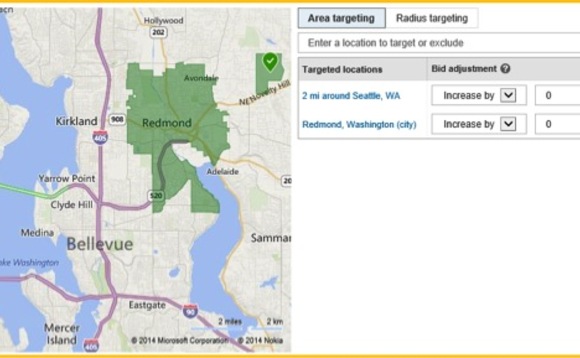Bing Ads Enhances Geo-Targeting for Increased Relevancy
Bing Ads' updates to its location targeting tools will help advertisers refine and define their geo-targeting for PPC.
Bing Ads' updates to its location targeting tools will help advertisers refine and define their geo-targeting for PPC.
Bing Ads is releasing enhanced location targeting that will include several new and important updates that help advertisers refine and define their geo-targeting for PPC.
Besides increased relevancy, many of the updates also support hyper-local targeting, most common on mobile devices.
“The increase in mobile volume has made hyper-local targeting more relevant from user intent and location accuracy point of view,” commented Piyush Naik, senior program manager at Microsoft. “Location accuracy is also greater on mobile due to more precise device location signals such as GPS being available, when users choose to share that.”
From hyper-local targeting to intent targeting settings, there are several new location targeting options advertisers can choose from.
Radius targeting improvements have been launched in the past month and are available to all advertisers. Until now, advertisers could only geo-target in predefined increments of 5, 10, or 20 miles from the radius. Now, a radius can be specified in either miles or kilometers and new limits range from 1 to 500 miles or 1 to 800 kilometers in increments of 1 mile or kilometer.
Both location and radius targets can be used in the same campaign or ad group. For example, targeting can include a city and also a radius target around a second location.

New ZIP code targeting and exclusion features are in beta mode and are expected to be available to all advertisers by end of September. Up to 10,000 location targets in a campaign or ad group is possible and bids can be adjusted by each ZIP code for even more customization.
Intent-only targeting has been launched in the past month and enables campaigns to show only to those searching or viewing pages about a targeted location, rather than where the user physically resides. For example, a searcher who is planning to travel may be searching for something in their destination city. Targeting ads to them with specific messaging can help capture the sale when they get in town.

Advertisers will see more granular insights in reporting on the type of location-getting results. A column for “location type” will specify either a physical location or location of interest. Data for “most specific location” has been added to provide the most detail possible.
Many advertisers may see lower volume as they narrow down location targeting. Since more specificity reduces volume, advertisers may need to test and optimize geo-targeting to find the right balance of volume/reach and relevance to get the best performance from Bing Ads.